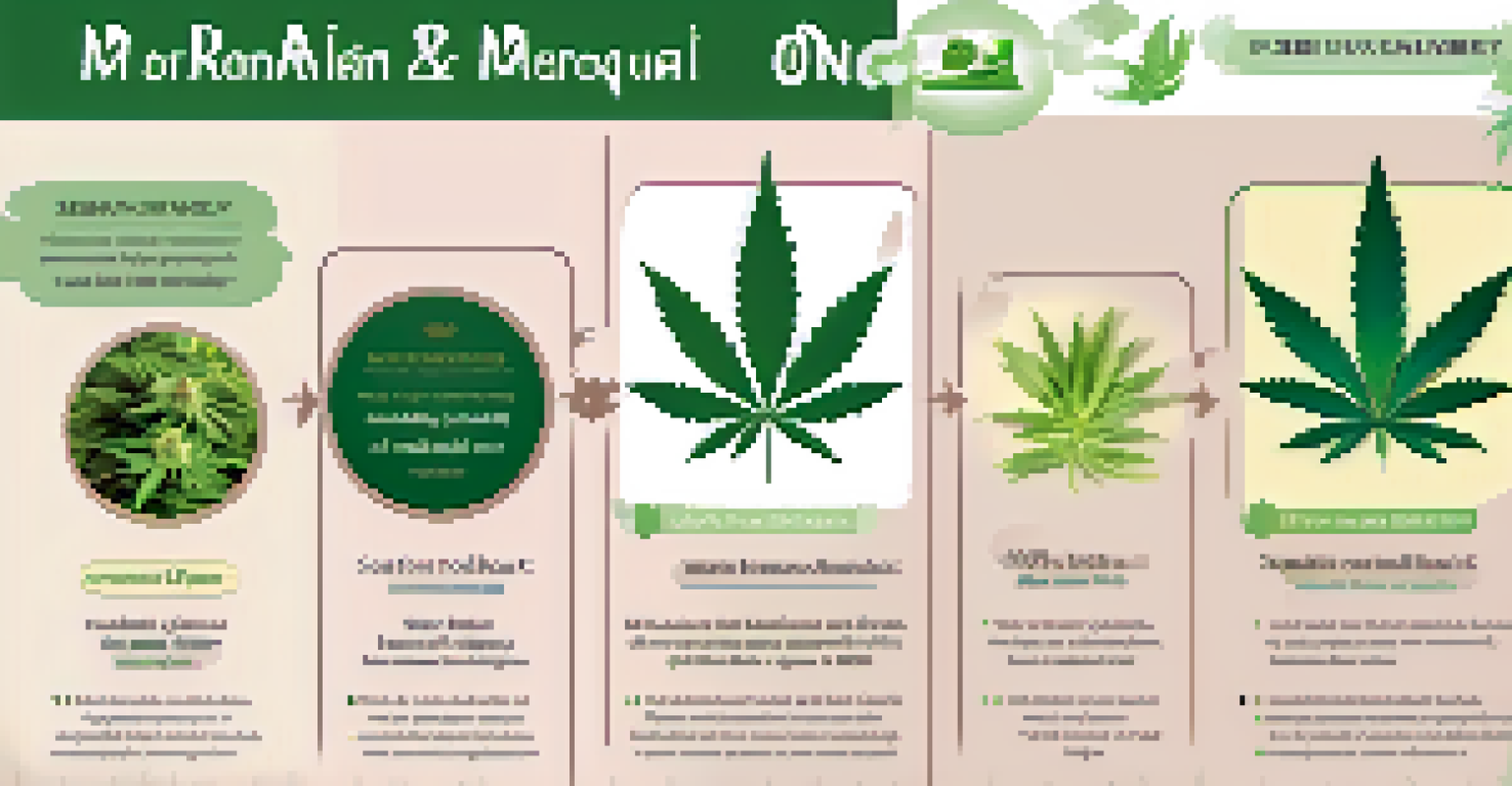Consumer Preferences: Organic vs. Non-Organic Marijuana Products

The Growing Interest in Organic Marijuana Products
In recent years, there has been a noticeable shift towards organic marijuana products among consumers. This trend is largely driven by a growing awareness of health and wellness, with many individuals seeking natural alternatives to enhance their lifestyles. Organic products are often perceived as safer and more environmentally friendly, attracting those who prioritize sustainability in their purchasing decisions.
The greatest wealth is health.
Moreover, organic marijuana is typically grown without synthetic pesticides or fertilizers, which resonates with consumers concerned about chemical exposure. This appeal is not just about health; it also reflects a desire to support responsible farming practices. As consumers become more educated about where their products come from, the demand for transparency in cultivation methods grows.
Ultimately, this movement towards organic options signifies a broader cultural shift towards holistic living. Consumers are not just looking for a product; they are seeking a connection to their food and the environment. This desire for authenticity is influencing purchasing patterns, leading many to prefer organic marijuana over its non-organic counterparts.
Understanding Non-Organic Marijuana Products
Non-organic marijuana products hold a significant place in the market, often appealing to a different segment of consumers. Price is a major factor; non-organic options are typically less expensive due to the cost-effective methods used in production. For many consumers, budget constraints can be a deciding factor when choosing between organic and non-organic products.

Additionally, non-organic marijuana can offer a consistent experience, which some users appreciate. Growers often utilize specific nutrients and techniques to maximize yield and potency, resulting in products that are reliable in effects and quality. This consistency can be particularly appealing for recreational users who prioritize specific experiences.
Rise in Organic Marijuana Demand
Consumers are increasingly gravitating towards organic marijuana products due to health, sustainability, and a desire for transparency in cultivation.
Despite the concerns surrounding pesticides and chemicals, some consumers feel that non-organic products still meet their needs without compromising quality. This perspective emphasizes the importance of understanding individual preferences and experiences when it comes to marijuana consumption, as not every user places the same value on organic certification.
Health Considerations in Consumer Choices
Health considerations play a crucial role in the decision-making process for marijuana consumers. Many choose organic products to avoid potential health risks associated with chemical pesticides and fertilizers. This concern is particularly important for those using marijuana for medical purposes, where the purity and safety of the product can significantly impact its efficacy.
What we eat is a matter of life and death. It is a matter of health and disease, of happiness and sadness.
Conversely, some consumers of non-organic marijuana may prioritize other health aspects, such as THC or CBD content, over organic certification. For these individuals, the effects of the product might take precedence over how it was grown. This highlights the diversity in consumer priorities and how they influence purchasing decisions in the marijuana market.
Ultimately, the conversation around health and product choices is multifaceted. Each consumer approaches their preferences with different values, leading to varied interpretations of what constitutes a 'healthy' product. As awareness of health implications continues to evolve, so too will consumer preferences in the marijuana industry.
Environmental Impact of Organic vs. Non-Organic Farming
The environmental impact of marijuana cultivation is a significant factor for many consumers, especially those who choose organic products. Organic farming practices often emphasize sustainability, including reduced use of harmful chemicals and a focus on soil health. This resonates with environmentally conscious consumers who want their purchases to align with their values.
In contrast, non-organic farming can lead to higher levels of environmental degradation due to chemical runoff and monoculture practices. While some consumers may not prioritize these issues, a growing segment is increasingly aware of the ecological footprint of their choices. This awareness can influence their preferences, leading them to support organic growers who practice sustainable methods.
Budget Influences Non-Organic Choices
Price remains a significant factor for consumers opting for non-organic marijuana, as these products often provide a more cost-effective alternative.
As the market evolves, the environmental implications of both organic and non-organic marijuana will continue to shape consumer preferences. Educating consumers on these impacts is essential for fostering informed decisions, ultimately encouraging a more sustainable future for the industry.
The Role of Certification in Consumer Trust
Certification plays a pivotal role in building trust among consumers regarding organic marijuana products. Many consumers rely on organic certification as a guarantee that the product has been grown and processed without synthetic chemicals. This assurance can significantly influence purchasing decisions, especially for those who are health-conscious or environmentally aware.
On the other hand, the lack of certification for non-organic products can lead to skepticism among consumers. Without clear labeling or standards, it's challenging for consumers to know what they are getting. This uncertainty can deter some from purchasing non-organic marijuana, even if they might be open to it under different circumstances.
As consumer preferences continue to evolve, the importance of certification will likely grow. Educating consumers about what certifications mean and how they impact product quality can help foster a more transparent market, ultimately benefiting both consumers and producers.
Consumer Education: What Matters Most?
Education is essential in helping consumers make informed choices between organic and non-organic marijuana products. Many consumers may not fully understand the differences between these categories or the implications of their choices. Therefore, providing clear, accessible information can empower them to prioritize what matters most to their individual needs and lifestyles.
For instance, some consumers may prioritize potency and flavor, while others may focus on the absence of chemicals. By understanding their personal preferences, consumers can better navigate the often-complex marijuana market. This kind of targeted education can also help dispel myths and misconceptions surrounding both organic and non-organic products.
Education Drives Informed Decisions
Providing clear information about organic and non-organic marijuana can empower consumers to make choices that align with their values and preferences.
As more consumers seek knowledge about what they consume, the demand for educational resources will likely increase. Brands that take the initiative to educate their audience not only build trust but also foster a loyal customer base that feels confident in their purchasing decisions.
Future Trends in Consumer Preferences
Looking ahead, consumer preferences regarding organic and non-organic marijuana products are likely to continue evolving. As awareness of health, environmental, and ethical considerations grows, the demand for organic options may rise further. This shift can encourage more growers to adopt organic practices, enriching the market with diverse offerings that cater to changing consumer tastes.
At the same time, non-organic products will still retain their appeal, particularly for budget-conscious consumers or those seeking specific effects. As the market expands, it will be crucial for producers to cater to both segments effectively, ensuring that all consumers can find products that meet their needs.

Ultimately, the future of consumer preferences will hinge on the ongoing dialogue around health, sustainability, and quality. As consumers become more discerning, both organic and non-organic sectors will need to adapt, creating a dynamic and responsive market that reflects the values and desires of its audience.